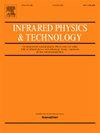Depth and angle evaluations of oblique linear cracks in metal using multi-speed laser lock-in thermography method
Abstract
Cracks can develop obliquely to the metal surface. The multi-speed laser lock-in thermography method is suited for the contactless estimation of open crack angles and depths in metal with oblique linear cracks. A continuous laser source regularly scans the studied sample leading to a periodical heating. The heat diffusion disturbances induced by a crack located in the thermal diffusion area are measured synchronously with the repeated continuous laser scan passes. The thermal signature of the crack is extracted from the amplitude of surface temperature images for various scanning speeds of the thermal source. The asymmetry of the thermal signatures obtained on each side of the crack is analysed as a function of a length relying on the thermal diffusion length. The local crack depth and crack angle are evaluated simultaneously. The method, explained with 3D simulations, is experimentally implemented and tested with calibrated oblique linear cracks. The results demonstrate the potentiality of multi-speed laser lock-in thermography method as a contactless measurement tool for the evaluation of oblique crack shapes up to 3.5 mm depth.

 求助内容:
求助内容: 应助结果提醒方式:
应助结果提醒方式:


